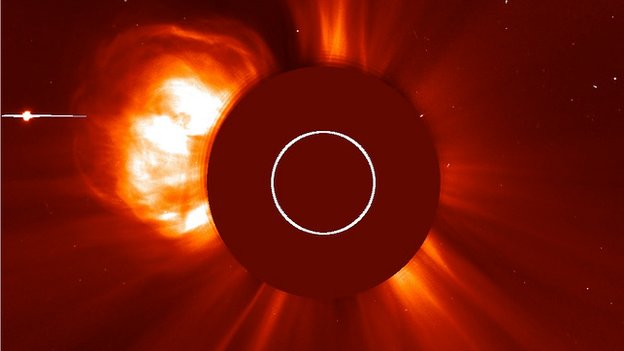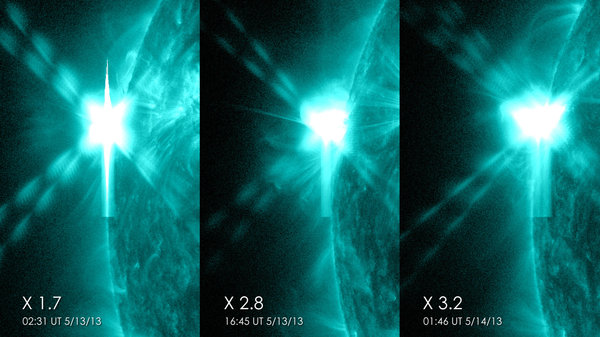.

The Sun has unleashed its most powerful eruption of 2013 so far.
The solar flare - a sudden release of radiation - peaked at 1705 BST on Monday, and was associated with a huge eruption of matter.
When these eruptions reach Earth, they can interfere with electronic systems in satellites and those on the ground.
Nasa said this solar explosion - known as a coronal mass ejection (CME) - was not directed at Earth, but it could pass several US spacecraft.
The event on Monday was classified as an "X-class" flare - the most intense type - with a designation of X2.8 (higher numbers denote a stronger flare). It surpassed an X1.7-class flare that occurred 14 hours earlier.

They are the first X-class events to occur this year.
When intense enough, a flare can disturb the Earth's atmosphere in the layer where GPS and communications signals travel.
This disrupts the radio signals for as long as the flare is ongoing - the radio blackout associated with this flare has since subsided.
CMEs can be even more disruptive because they can send billions of tonnes of solar particles into space. In those cases when very strong eruptions do reach Earth, the charged matter can blow out transformers in power grids.
The so-called Carrington Event of 1-2 September 1859 shorted telegraph wires, starting fires in North America and Europe, and caused bright aurorae (northern and southern lights) to be seen in Cuba and Hawaii.
The CME associated with this flare may pass the Stereo-B and Spitzer spacecraft. The operators of those science missions can choose to put their spacecraft into a "safe mode" to protect the electronics in onboard instruments from being tripped.
Increased numbers of flares are expected at the moment because the Sun's normal 11-year activity cycle is approaching a "high" of activity - known as a solar maximum.
Quelle: NASA
.

The sun put on another fireworks display Monday evening, releasing a dramatic flash of ultraviolet radiation and sending solar matter hurtling through space.
It was the third major solar flare in 24 hours and the most powerful of 2013.
The solar flare triple threat started Sunday evening when the left flank of the sun exploded with an X1.7 solar flare -- the first X class solar flare of 2013. That was followed by an X2.8 solar flare Monday morning, and an X3.2 solar flare Monday just after 6 p.m. PDT.
All three solar flares originated from sun spots in an area of the sun known as AR 11748. This volatile region of the sun's surface, with its groups of sun spots and tangle of magnetic loops, is just starting to turn the corner of the sun's sphere and peak out toward Earth.
"It's been hard to see completely because it was around the corner," said Alex Young, a heliophysicist at Goddard Space Flight Center. "We can see it is complicated but it is hard to get a good picture -- we will have to wait till it rotates around."
He added that the region is relatively small for an active region -- about the size of two Earths.
Each of the three solar flares was also associated with a Coronal Mass Ejection (CME) -- when the sun flings millions of tons of its plasma and other solar material hurtling through space.
NASA's research models suggest that the CME associated with the most recent solar flare left the sun at about 1,400 miles per second, which is almost twice as fast as the other two CMEs. NASA scientists think it will catch up and merge with the CMEs released by the previous two solar flares to create an especially enormous cloud of solar matter.
When these CMEs come flying through space toward Earth they interact with the planet's magnetic field, occasionally causing radio blackouts and, in extreme cases, disrupting power. They can also interfere with satellites in space.
None of these three CMEs are headed toward Earth, however.
NOAA's space weather forecasters say there is a 40% chance of more X-class solar flares in the next 24 hours.
"In many ways, one of the biggest indicators of a big flare happening is a big flare happening," Young said.
But he added that forecasters will know more when they can get a better look at the region and see its magnetic configuration.
All this sun activity may be dramatic, and beautiful to watch through the images captured by NASA's Solar Dynamic Observatory, but it is not unexpected. The sun goes through an 11-year cycle of activity and 2013 is the peak of solar maximum.
"Three solar flares in a row is interesting," said Young, "especially because there weren't many medium-class solar flares in between. I don't know that it is that special, but it is interesting."
Quelle: Los Angeles Times
4925 Views

